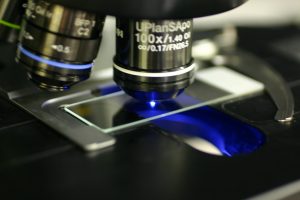Customizing Fluorescence Microscopy for Precision Imaging
Fluorescence microscopy, a powerful tool in scientific research, thrives on meticulous customization of its components to achieve optimal performance. Part 2 of this series delves into the essential customization of filters and lenses, exploring how these modifications enhance the microscope’s ability to capture high-resolution fluorescence images.

Fluorescence Microscopy
Filters in Fluorescence Microscopy
Unlike conventional brightfield or darkfield microscopes, fluorescence microscopes employ specialized filtering techniques to isolate emitted light from fluorophores. Three key filters play a pivotal role in this process:
- Excitation Filter: Positioned in the illumination path, this filter selectively allows the excitation range of the fluorophore to pass through, filtering out unwanted wavelengths from the light source.
- Dichroic Filter: Placed at a 45° angle between the excitation and emission filters, the dichroic filter reflects the excitation signal towards the specimen and transmits the emission signal towards the detector.
- Emission Filter: Located within the imaging path, this filter permits only the emission range of the fluorophore to pass through while blocking the entire excitation range.
Lens Customization for Enhanced Performance
Customizing lenses further enhances the microscope’s capabilities. Several approaches are employed to tailor lenses to specific requirements:
- Modifying Lens Design: Optical design software optimizes lens shape and curvature, ensuring alignment with focal length, magnification, numerical aperture, distortion correction, and other specifications.
- Special Coatings: Applying coatings to the lens surface minimizes reflection and scattering, enhancing transmission in specific wavelength ranges. For fluorescence microscopy, coatings may reduce signal loss and maximize transmittance in relevant wavelengths.
- Material Modification: Utilizing different materials modifies the lens’s performance, allowing for choices that provide higher transmittance in specific wavelengths or increased durability in challenging environmental conditions.
- Special Shapes and Sizes: Custom lenses can be crafted in unique shapes and sizes, facilitating seamless integration into specific optics or equipment, including the use of aspherical or asymmetric lenses for specialized applications.
Advantages of Lens Customization
Customized lenses offer several advantages, including optimal performance tailored to specific requirements, suitability for harsh environments, and the potential to enable new technologies and applications.
- Optimal Performance: Custom lenses are designed to meet specific requirements, ensuring optimal optical performance and resolution.
- Suitability for Special Environments: Lenses can be selected to withstand harsh conditions, enhancing reliability and durability in specific applications.
- Enabling New Technologies: Customized lenses may lead to the development of new technologies, addressing unique research or industry needs and providing novel insights and results.
In conclusion, customization in fluorescence microscopy involves precise selection and design of filters and lenses to efficiently capture and visualize fluorescence emissions. These tailored modifications empower scientists and researchers to explore biological processes at the single-molecule level, contributing to advancements in medicine, biology, and materials science.
Do not hesitate to contact Shanghai Optics today. We’d be more than happy to discuss your projects and how best they can become a success.
